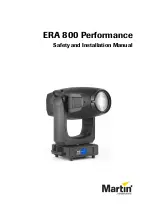
702 User Guide and Technical Information
17
Input Linking (Stereo or MS Decoding)
Analog inputs 1 and 2 can be linked as a stereo pair. When linked, the channel 1 front panel potenti-
ometer controls the signal level of both inputs, and the channel 2 pot controls the left-to-right balance
of the pair. When the inputs are linked, their peak limiters are linked, as well.
When set to link as an MS pair, the inputs are decoded as left/right stereo, where the gain and bal-
ance for the pair work the same as stereo linking above. Input 1 is for Mid signal, input 2 for Side
signal.
When the inputs are linked, phantom power and the high pass filters also act as linked pairs. Engag-
ging and disengaging phantom power or the high pass filters on input one will force the same func-
tion upon input two. Engaging or disengaging phantom power or the high pass filter on input two
causes no effect on input one.
If MS stereo linking is selected for inputs, program sent to tracks and headphones will be L/R stereo pro-
gram. To record discrete M and S signals, do not link for MS, but monitor the MS signal in headphones.
Things to consider when Linking Input 1,2 as MS:
• Digital Inputs cannot be linked as an MS pair.
• If linking Line Inputs as an MS pair, the Setup Menu option
LINE INPUT 1,2: GAIN CTRL
must be set to Use Front Panel Knobs.
Digital Input – AES3
The 702 accepts AES3 (AES/EBU) balanced digital at the input 1 XLR connector. Digital input is two-
channel—AES3 signals on XLR-1 appear at inputs 1 and 2. To use the AES3 input, the input mode-
select switch must be set to AES/EBU. There is no level control for AES inputs.
The front panel digital input LEDs illuminate when digital signal is selected as input. If the
LED is flashing, digital input is selected but a no valid digital clock is being received.
Digital Input – AES3id (S/PDIF)
The 702 accepts AES3id and S/PDIF unbalanced digital signals on the BNC connector. The 702 will
auto detect the type of digital signal and adjust accordingly. Like AES3 signals, this is two channel
input. There is no level control for AES3id inputs.
AES3id inputs override analog signals present at the XLR inputs. To use analog sources while using
the AES3id signal as a digital clock source, select analog in the input source menu selection.
When a digital signal is present, the 702 locks its sample rate to its source frequency. This lock is indi-
cated by a highlighted block on the main LCD display to the right of the bit depth and sample rate
indicators. Recording bit depth is independent of the external digital source.
When locking the 702 to an external digital signal, be certain the source is stable. Loss of digital
signal will cause the 702 to revert to its internally set sample rate, even while recording. The portion
of the file recorded after the loss of signal may not play back properly. Once recording has begun,
unused digital inputs are muted, digital signals that appear on them after the record button has been
pressed will not be recorded or affect the sample rate of the 702.
The 702 clocks itself to the first digital signal presented to it. If the 702 detects a digital signal on the
BNC inputs and locks to that signal, a digital signal applied to the XLR input will be ignored until the
first digital signal is removed.
Содержание 702
Страница 2: ...backside front cover ...
Страница 78: ...702 rev 2 67 Printed in U S A ...
















































